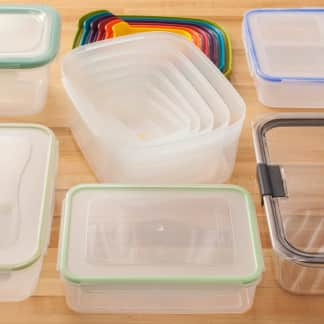Using plastic wrap to keep foods fresh is convenient, but as a single-use product destined for the landfill, plastic wrap can be wasteful, and its tendency to get tangled and stick to itself can make it frustrating to use. Reusable food wraps—sheets of cotton or hemp dipped in a layer of beeswax or soy wax—are an increasingly available alternative. Manufacturers advertise that these wraps are as effective as traditional plastic wrap at keeping food fresh. They can be wrapped directly around food or used to seal bowls and other containers. To use them, you fold and overlap the material and press firmly to adhere the wrap. When you’re done, you can clean them with a bit of soap and water, store them, and reuse them. The wraps gradually lose their clinging ability over time and can then be cut into strips and composted or even used as simple fire starters. According to most manufacturers, they're good for about a year of regular use. We tested six sets, priced from about $3 to about $6 per wrap, against one another and our winning plastic wrap to see which would perform the best.

We evaluated the wraps’ versatility by using them to cover bowls of various materials and sizes. We checked their clinging ability by vigorously shaking bowls that we’d filled with grapes and sealed. We compared the wraps’ food storage effectiveness by using them to wrap and store loaves of bread and halved lemons, avocados, and onions, checking if they retained odors. We crushed blackberries onto them to see if they stained. Finally, we washed each wrap more than 10 times—by hand, since none were dishwasher-safe—to get a sense of its durability. We were looking for a wrap set that preserved food well, was easy to use and clean, and held up to consistent use over time.

Testing Cling
These wraps’ success depends on how well they can adhere—both to themselves and to containers. Each wrap’s components are very similar: fabric dipped in beeswax or soy wax, as well as jojoba oil, coconut oil, and/or tree resin for added stickiness and flexibility. Manufacturers were reticent to disclose their exact formulas, but we noticed some differences in texture and clinging ability that suggested that companies use different proportions of wax, oil, and tree resin. Two of the wraps were extremely sticky and malleable. They folded and stuck well to themselves and the bowls we tried them on, creating seals that held fast during the grape test. But there was a downside to those supersticky wraps. While all left some oily residue on our hands and the bowls’ rims, the especially sticky wraps left gunky, waxy residue everywhere. We were able to easily scrub away the residue from our fingers and the bowls’ rims with soap and a sponge, but it was messy and inconvenient nonetheless. Two of the wraps were stiffer and difficult to manipulate. They didn't adhere well; during the grape test, the wraps came unstuck and fruit went flying everywhere. But they also left behind less waxy residue on our hands and dishes, a sign they were likely made with less wax or oil. The remaining two wraps were just right. They were flexible and clingy enough to seal the bowls tightly, all while keeping the bowls’ rims, as well as our hands, relatively free of oil and wax. The wraps adhered to the bowls just as well as plastic wrap but without all the pesky tangling and sticking.

Wrapping And Storing Food
We were interested in learning how well the wraps preserved foods, especially in comparison with plastic wrap, so we wrapped and sealed halved loaves of bread and halved lemons, onions, and avocados in the most appropriately sized reusable wraps from each set. We stored the breads in the pantry and the produce in the refrigerator for three days. The wraps’ differences in performance were highlighted when we compared the halved loaves of bread and avocados. The bread wrapped in plastic wrap stayed the freshest, with only slight staleness creeping in by day three. The two stickiest wraps and the two moderately sticky wraps created good seals that preserved their breads almost as well as the plastic wrap. The breads stored in the two rigid, nonsticky wraps were rock-hard and stale by day three. The avocado test revealed similar results: Avocado halves stored in the stickier wraps showed less oxidation than the halves wrapped in the stiffer, less sticky wraps. All in all, we preferred the wraps that kept every food fresh throughout our tests.

We were also interested in whether the wraps would leave residue on food during storage, but we didn’t notice any. When we handled the wraps in our hands to test them with bowls, our body heat warmed up the wax mixture, and we applied forceful pressure to the wraps as we worked to adhere them to bowls, causing them to stick well and leave behind residue on our fingers. None of the foods we stored with the wraps were warm enough to melt the wax, and we weren’t applying enough pressure on the foods for the wax to get left behind.
Odor, Staining, And Durability
While plastic wrap is easily disposed of after a single use, reusable wraps must be washed after each use. There were stark differences between the wraps when it came to cleaning. After each storage test, we washed the wraps according to manufacturer instructions: using cold water, a small amount of dish soap, and the soft side of a sponge. Throughout all the storage tests, we noticed that the stickier wraps held on to errant crumbs, seeds, and pulp more steadfastly than less sticky wraps, even when we tried to scrub them away. However, two of the wraps were sticky enough to create good seals but not so sticky that they were difficult to scrub clean. Every wrap retained onion odor throughout the rounds of washings over the next few days, but the odor faded eventually with time and additional cleaning. While odors did fade, it was clear that the wraps did best with foods that didn’t have overwhelming odors.


We also crushed blackberries into the wraps and let them sit overnight before cleaning them to see how much they stained. The less sticky wraps were stained the worst; it took multiple washings to remove the blackberry stains from some of these, and some even held on to stains after more than 10 washings. The stickier wraps retained or showed fewer stains, perhaps because they had thicker layers of wax than those of their less sticky counterparts, which blocked absorption of the blackberry juice. At the end of our washings it seemed that all the wraps shed at least a little bit of wax during all that scrubbing. While this did little to affect their overall clinging ability throughout our short testing period, we’re sure they will all wear out eventually. But we’re optimistic about them lasting throughout the manufacturers’ suggested lifetimes, and all the wraps are inexpensive enough to replace without fuss when the day comes to compost them.
The Best Reusable Food Wraps: Abeego Food Wrap
Our winning food wraps, a three-piece set made by Abeego (about $6 per wrap), created tight seals that preserved food almost as well as plastic wrap without coating our hands in too much waxy residue. They were easy to clean, and any stains or odors they retained were mostly gone after only a few washes. They were durable and retained their clinging ability after more than 10 washes. These wraps take more effort to maintain than single-use plastic wrap, and eventually you’ll have to replace them. Still, we think the Abeego wraps are an affordable and environmentally responsible alternative to plastic wrap.
- Clingy, malleable material creates strong seals
- Leaves minimal residue on bowls and hands
- Keeps food fresh
- Washes clean and holds up to repeated washing
- Test six sets of reusable wraps, ranging in price from about $3 to about $6 per wrap
- Cover and seal glass, metal, ceramic, wood, and plastic bowls of various sizes with the most appropriately sized wraps to test versatility
- Fill bowls with grapes, seal with the wraps, and shake vigorously to test clinging ability
- Cover, seal, and store half loaves of bread as well as halved onions, lemons, and avocados and evaluate freshness after three days
- Check the wraps for traces of onion odor
- Crush blackberries in the wraps, let them sit overnight, and evaluate for stains after washing
- Wash the wraps an additional 10 times and check for signs of wear












